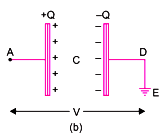In fig. (a) Three capacitors of capacitances C1, C2, C3 are connected in series between points A and D.


In series’ first plate of each capacitor has charge +Q and second plate of each capacitor has charge –Q i.e., charge on each capacitor is Q.
Let the potential differences across the capacitors C1, C2, C3 be V1, V2, V3 respectively. As the second plate of first capacitor C1 and first plate of second capacitor C2 are connected together, their potentials are equal. Let this common potential be VB.
Similarly the common potential of second plate of C2 and first plate of C3 is VC. The second plate of capacitor C3 is connected to earth, therefore its potential VD=0. As charge flows from higher potential to lower potential, therefore
VA>VB>VC>VD.

Adding (i), (ii) and (iii), we get

If V be the potential difference between A and D, then
VA - VD = V
\(\therefore\) From (iv), we get

If in place of all the three capacitors, only one capacitor is placed between A and D such that on giving it charge Q, the potential difference between its plates become V, then it will be called equivalent capacitor. If its capacitance is C, then
V = \(\cfrac QC\).....(vi)
Comparing (v) and (vi), we get
